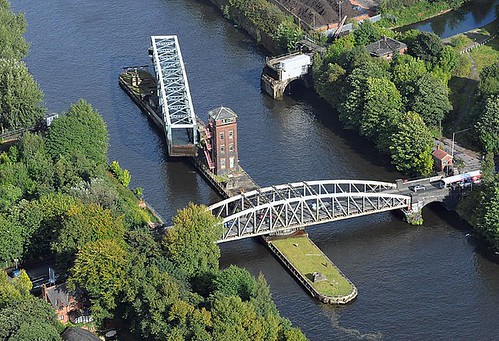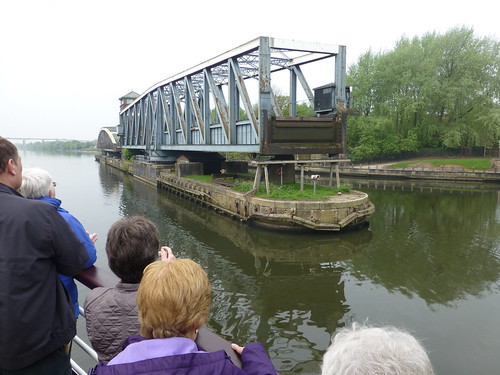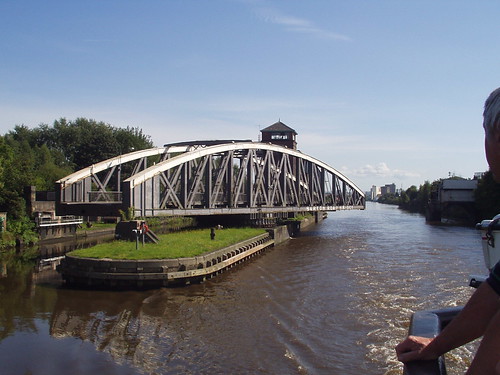The Barton swing aqueduct on the Manchester Ship Canal is not only the
World's first swing aqueduct, it is also World's only such aqueduct. Built in
1894 it is considered as an engineering marvel for that time.
The aqueduct located near Barton upon Irwell, Greater Manchester, carries the
Bridgewater Canal over Manchester Ship Canal. Unlike other aqueducts, it swings
open to allow movement of large ships in the Manchester Canal. In closed potion
it allows passage of smaller boats plying in the Bridgewater Canal to cross the
Manchester Canal below it.
This is second aqueduct at the location. The first one built 1761 was a
conventional masonry aqueduct with fixed spans. The old aqueduct carried the
Bridgewater Canal over River Irwell. Later with the construction of Manchester
Ship Canal running parallel to the river, the height of old aqueduct was found
to be inadequate for passage of larger ships in the Manchester Ship Canal. It
was therefore replaced in 1894 by the present swing aqueduct and is in use even
today.
The swing aqueduct consists of iron trough supported in a steel girders
frame, which is mounted on a centre pivot allowing it to be rotated by 90
degrees. The moving portion of the aqueduct is 71.6m (235 ft.) long and 7.3m (24
ft) wide. The trough which sits inside the frame is 5.5m (18 ft) wide and 2.1m
(6.9 ft) deep. Both the fixed portion as well as the moving portion of the
aqueduct have rubber wedge gates on each end to retain the water in the canal as
well as in the trough. Total weight of the swing aqueduct is 1,450-tonne which
includes about 800 tonnes of water.
The swing mechanism rests on a purpose built island in the
middle of the Manchester Ship Canal. As per
Wikipedia "the
turning mechanism built into the central island consists of a 27-foot (8.2 m)
race plate embedded in granite blocks. Sixty-four tapered cast iron rollers sit
on top of the race plate, held in position by a spider ring. On top of that an
upper race plate supports the aqueduct and its circular gear rack, which was
powered by a hydraulic engine."
The hydraulic engine was initially powered by two steam
boilers located on one of the bank of the Manchester Canal. Later the the
hydraulic force was obtained using electric pumps.
The control room for controlling the opening/closing of the
aqueduct and movement of the ships is located in a 4 storied tower in the middle
of the island. Nearby swing bridge for road traffic is also controlled from this
tower.
Following picture shows the swing aqueduct (left) and swing
bridge (right) in fully closed position.

Image from Wikimedia Commons is by RuthAS

Image from Flickr is by Airviews Photography
Aqueduct in fully open position allowing the ship to pass through.

Image from Flickr is by Ted Milton
The aqueduct in closed position allowing the boat to cross over the Manchester Canal. Originally it had a towpath along its length about 2.7 m (9 feet) above the water level but it was subsequently removed.

Image from geograph.org.uk is by Peter Whatley

Image from Panoramio is by Adventures of Kara
Nearby Swing Road Bridge

Image from Flickr is by War Head
An explanatory video of the swing action.
Source of info and more info: Wikipedia / Engineering Timelines
View location in Google Earth / Google Maps (3D View) / MSN Bing Bird's Eye View

No comments:
Post a Comment
Please feel free to write your comments but remember that the same are moderated. So please do not post SPAM comments i.e. your business links here including surrogate links.
Comments containing SPAM are liable for rejection.